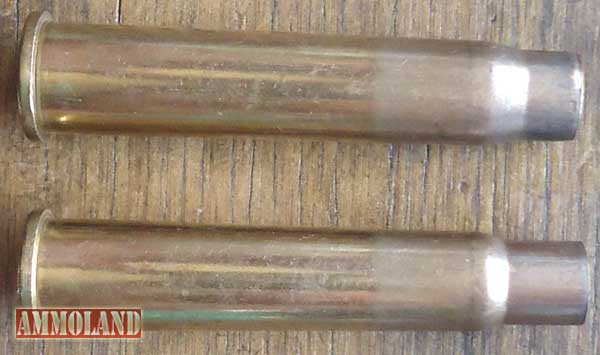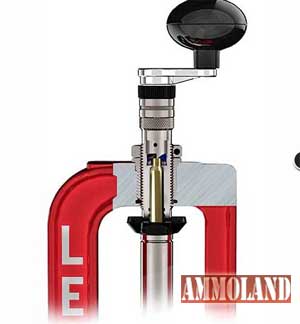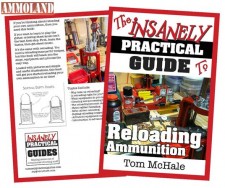Bob Shell provides an introduction to ammunition reloading dies.


Apache Junction, AZ –-(Ammoland.com)- The following is a quick primer on reloading basics including a series of three videos by rldel149 followed with written comments by Bob Shell.
“This is a part of a multi-part series on the very basics of ammunition reloading dies and miscellaneous other simple tools. ”
“It discusses some personal experience with various brands and calibers. Your experience and opinions may differ.” ~ rldel149
Comments by Bob Shell: After you get your cases ready for sizing the die has to be set. If they are bottleneck cases lubing is necessary.
Normally when you set a sizing die it goes all the way in.
To set the die bring the ram all the way up and screw the die until it touches. That will full length size the case. Some people believe that if you leave it a couple turns back it will neck size only. That is not true. You can try that and see for yourself that it will partially size the neck. They make dies for neck sizing only which some target shooters use. In theory neck sizing dies extend the case life though in reality I have some doubts.

As a rule full length sizing is the best method. Using that method, you shouldn’t have an issue with chambering your ammo. Even if you have more then one rifle for that round they should all fit. Of course as with everything, there are exceptions. Semi auto rifles have issues chambering reloaded ammo. Due to the lack of camming power rounds for the semi auto rifles have to be well sized. Some of your more common rounds such as the 308 have dies that are known as Small Base Dies . They bring the brass down to factory specs, which should insure chambering.

Also with those cases it is very important to trim with a tool like the Lee Deluxe Quick Trim Case Trimmer to minimum length. Failure to follow those steps will result in ammo that probably won’t chamber in a semi or pump action rifles.
If you are going on a hunting trip it is an excellent idea to chamber each round making sure if feeds through your magazine. It is a lot easier to fix the ammo in the shop rather out in the woods.
When a case is sized the shoulder gets pushed back by a small amount which helps with the chambering. The neck gets sized which enables it to properly grip a bullet. In addition the body is sized but not down to factory specs as it usually isn’t necessary. When sizing bottleneck cases be sure to use some lube otherwise you will have a case stuck in the die. Getting it out requires some effort and a stuck case remover kit .
Like all rules sometimes, it has to be broken. Many older guns have excess headspace which means that ammo that is reloaded in the standard way can separate in the chamber. Besides being very annoying, it can be dangerous to fire such ammo. One good example is many 303 British rifles. The dimensions are generally very generous which enables them to be used under less than ideal conditions such as dirt in the chamber.
While a good idea in the trenches, it does create problems for the handloader.
When you fire reloaded ammo in one you will frequently see a shiny ring about 3/8” above the rim. That is a sign that the case can separate upon firing again so they should be discarded. If in doubt, take a dental pick and run it on the inside of the case. If it catches that probably indicates an oncoming separation. With the British and similar rimmed rifles I set the die a couple of turns back and size the case. In the end, I size the case just enough to chamber without excessively sizing the case which resolves the problem. If you can convince someone to make a set of dies that size the neck only that would be nice. Other companies including LEE make Neck Sizing Dies so if there is a set in your caliber then you are in luck.
It is one of these situations that requires some thought to be successful but that is what makes reloading interesting. At a later point, we will discuss straight cases.

Another aspect of sizing is trimming the case.
They have a tendency to stretch after being fired. How much depends on various factors which I can’t go into because of space but will cover another day.
If a case is too long it can cause everything from difficult chambering to excessive pressure.
What happens is the excess brass is forced into the rifling, which constricts the bullet. The fix is easy just trim to the proper length.
That info is supplied in all of the Reloading Manuals , which is one of the many reasons to own at least one, better yet several.
This has been a short primer on reloading dies and their uses. Pleas leave us any questions and some comments on what you would like to discussed next.
About Bob Shell
A Custom Reloader of Obsolete and Antique Ammo, Bob Shell, writes about the subject of Guns, Ammo, Shooting and Related Subjects. Visit: www.bobshellsblog.blogspot.com

Been handloading since mid 1970s. Made a few mistakes along the way especially die setting. Split a few 223s in a Mini-14 back in the 1980s. One tool that I recommend with good faith for Rifle cartridges is the amazing RCBS Precision Mic. It helps the handloader make precise adjustment of the Resizing Die to produce a “factory” head space setting on your empty case. Comes in many popular bottle-neck calibers: 223, 308, 25-06, etc. Check it out.
Case on top headspaces on the rim. Apparently the gun chamber is out of specification.
I have been reloading .223 for about 2 years now. I have a Lee single stage press, the Deluxe Quick trim for .223, Lee Auto Prime, Lee 3 die set for .223, Lee Perfect Powder Measure, etc. I also have the die sets for 9mm. and 7.62X54R but have not reloaded 9 in some time since I have 2200 rounds on the shelf. I have some Lake City 5.56 brass I have reloaded 8 or 9 times and have had only 2 split the neck. I trim to 1.75″ and a few to 1.745″ for testing new loads. I bought… Read more »